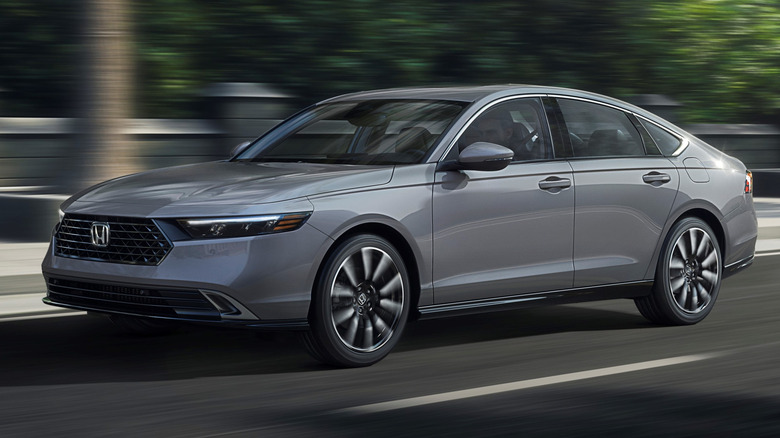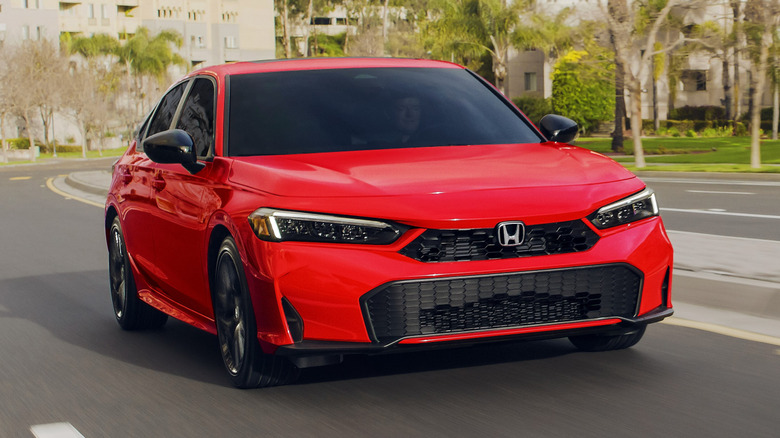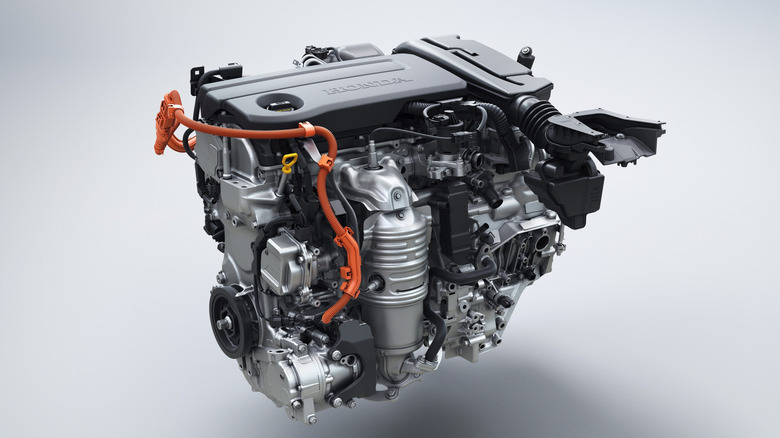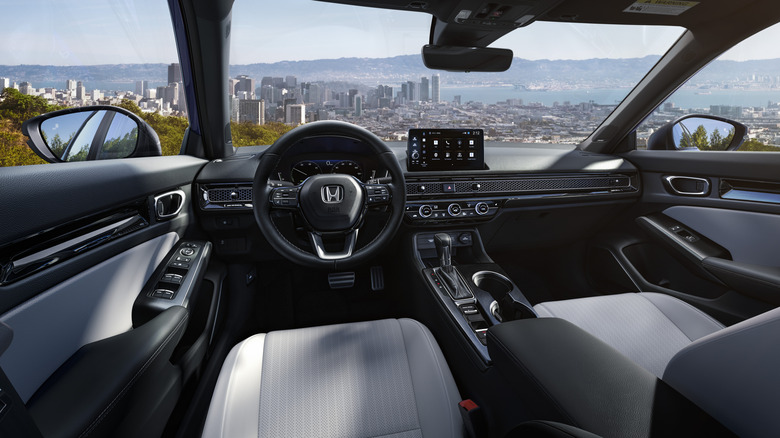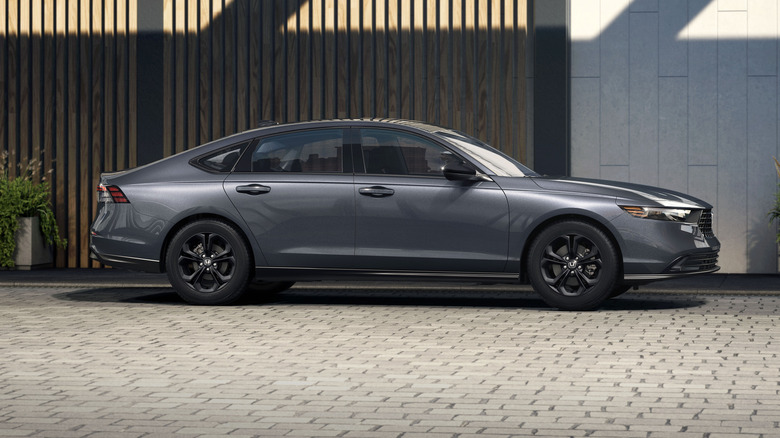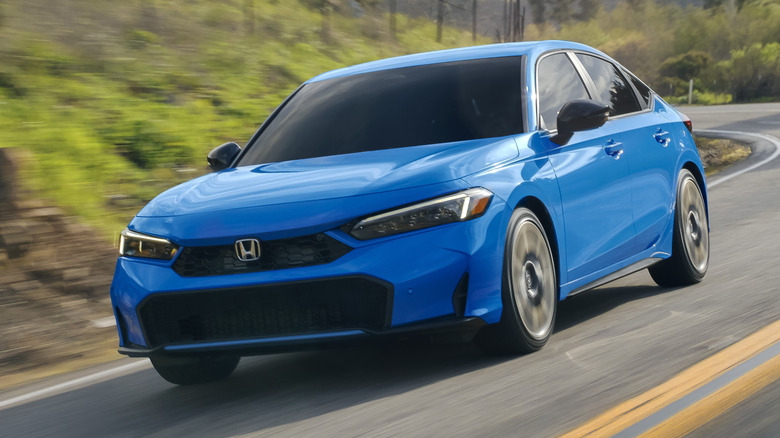Honda Civic Vs. Accord: What's The Difference & Which Is The Better Car For Your Needs?
The Honda Civic and the Honda Accord have both been around since the 1970s, and they are easily the longest surviving nameplates in the company's history. The Civic came first for the 1973 model year, while an oil crisis was ongoing, so having a car that boasted about getting 41 mpg on the highway was immensely appealing. The Accord arrived in the summer of 1976 and looked to take similar fuel efficiency and put it in a more luxurious, larger body. As recently as 2024, both models still rank among the 25 bestselling vehicles in the United States.
Due to their longevity, you may think you know what you are getting with the Civic and Accord, but despite them occupying roughly the same space in the sedan marketplace, there are plenty of differences between the two that would make someone prefer one over the other when looking for a new vehicle. We'll assess each of these cars to help you make that decision, covering everything from their powertrains to their convenience features to sizes and prices. In the end, you will hopefully know whether a Honda Civic or Accord is right for your day-to-day life.
Their classes and sizes
At their most basic level, the Honda Civic and Accord are both sedans. However, that does not mean that they are built to be equivalent in size. The Civic is the smaller of the two and is what would qualify as a compact sedan, with its 107.7-inch long wheelbase, a total length of 184.8 inches, a width of 70.9 inches, and a 55.7-inch height. With these exterior dimensions, that translates to a volume of 99 cubic feet for the passengers.
The Honda Accord, on the other hand, would be a mid-size sedan and sits on the slightly larger 111.4-inch wheelbase. The overall length is nearly 11 inches longer than the Civic, at 195.7 inches, and it's almost 2.5 inches wider too, at 73.3 inches. That may not seem like a lot, but the Accord has an overall volume of 105.7 cubic feet, with leg room for the rear seats at 40.8 inches, which is almost 3.5 inches more than the Civic.
These measurements can ebb and flow depending on what trim of the Civic or Accord that you choose, and there are some differences if you choose the Honda Civic hatchback too. While the sizes remain mostly the same, the big change comes form the rear cargo volume. The hatchback has a total volume of 24.5 cubic feet whereas the sedan has just 14.8 cubic feet. Unlike the Civic, the Honda Accord is not available as a hatchback, just a sedan.
The powertrains
In terms of what powers the 2025 Honda Civic and Accord, let's start with the differences arising in the traditional gas-powered versions of the models. The Honda Civic features a 2.0L I4 engine under the hood that will get you 150 hp and 133 lb-ft of torque. This is the case whether you are getting the Civic as a sedan or a hatchback. The larger Accord actually comes with a smaller engine, a 1.5L I4. However, this one comes equipped with a turbocharger, increasing the maximum output to 192 hp and 192 lb-ft of torque. This turbocharged engine can be found in one Civic model though, the Civic Si sporty sedan. There is also a turbocharged 2.0L I4 engine available for the Honda Civic Type R hatchback model – with the highest power output available for these models at 315 hp and 310 lb-ft of torque. No Accord trim offers that engine.
The Civic and Accord become similar with the hybrid powertrain available. Both models utilize a 2.0L I4 that is paired with two motors. All of that combined gives you an output of 200 hp and 232 lb-ft for the Civic, while the Accord is rated ever so slightly higher at 204 hp and 247 lb-ft of torque. Neither the Civic nor the Accord has an all-electric option available, the hybrid powertrain is the eco-friendly option.
The features
By and large, the 2025 Honda Accord and Civic are very similar vehicles when it comes to the technological and convenience features that are built in. For the LX trim, the most basic trim for each of the models, you can expect a 7-inch infotainment screen in the center of the dashboard where you are able to access features like Apple CarPlay and Android Auto, Bluetooth connectivity, and more. Being modern vehicles, the Civic and Accord have both adopted the push button start technology. As you move up the tier ladder, more features become available for the cars, such as Google Assistant and Alexa being built into the Civic Sport Touring Hybrid and Accord Touring Hybrid models, along with a 12-speaker Bose sound system with subwoofer, and a wireless phone charger.
The two models do have their minor differences though. For instance, the upper tier Civic models have a 9-inch screen, whereas the upper tier Accords have a 12.3-inch one. The Civic has two USB-C ports in the front console for smartphone and audio interface purposes. The Accord has just one for those media purposes, but it has an additional USB-C port up front and two more in the back for charging. One of the stranger outliers is that the basic Civic LX only features cupholders for the front seats, but every other trim for both models has them in the rear too.
The prices
Arguably more than anything, price is the determining factor when it comes to what car a person is going to buy. After all, it is a many-thousand dollar investment. It stands to reason that the Honda Civic is the more affordable of the two models, being the smaller and less powerful option. The base level 2025 Civic LX sedan has a starting price of $24,250, and the Accord counterpart sees that starting price go up to $28,295. The second least expensive Accord is the SE trim, starting at $30,560, and it is here where you see big savings on the Civic. Every other Civic sedan trim — with the exception of the Sport Touring Hybrid — is cheaper than the Accord SE. This ranges from the Sport trim starting at $26,250 to the Civic Si being the most expensive at $30,250. The Civic Sport Touring Hybrid starts at $31,950, and the most expensive Accord, the Touring Hybrid, starts at $39,300.
If you want a hatchback Civic model, that is going to cost you a few more thousand dollars than the sedan. The Civic Sport hatchback has a starting price of $27,450, and this goes up to the Sport Touring Hybrid, which starts at $33,150. The most expensive model is the 2025 Honda Civic Type R, the high performance hatchback option. This model has a starting price of $45,895, nearly doubling the starting price of the Civic LX. While convenience features and size obviously increase your sticker price, performance will always help break the bank.
Which Honda model is right for you?
The Honda Civic and Accord models have a ton in common, but the differences that have been covered throughout this article show that each one is better suited to certain scenarios. For example, the Accord is the better option for a family vehicle than the Civic. With its larger size, increased rear leg room, rear USB-C charging ports, and more, it shows itself to be a sedan that is best maximized when you have the car filled with people, rather than just a driver. Also, whether you are getting its turbocharged engine or hybrid powertrain, it is still going to deliver plenty of power to give you a satisfying driving experience with the larger size.
Then there's the Civic, which is more suited to those who typically have just one or two people in the car. If you need extra cargo room rather than passenger space, you have the hatchback options available to you. A high performance model is probably going to be more appealing to a single person rather than a family vehicle, so the Civic Si or Type R models would fit the bill. Nothing better signifies the Civic's appeal to this kind of consumer more than the LX model only having front seat cupholders. That setup isn't conducive to a family. Whichever kind of customer you are, Honda has a car for you that has about 50 years of history that will satisfy.
